Posted by Martin Andersen on 04-22-2008 12:51 PM:
6 Gull Tekke Torba tread?
Any chance of a 6 Gull Tekke Torba tread?
I would be very interested
in hearing about the members of this forum views on the aesthetics and the
design evolution of the 6 gull Tekke Torbas.
Here are some photos of my
own 6 gull Torba, which is fragmentized and with rather low pile. I suppose it’s
from around mid 19th (?) with no extraordinary features - but none the less I
certainly love the drawing and the quality of the weaving.
The size of
this Torba is 47 x 119 cm. Its open right, and 364 kpsi (as far as I can count).
I suppose its a rather high kpsi for relatively large Torba ?
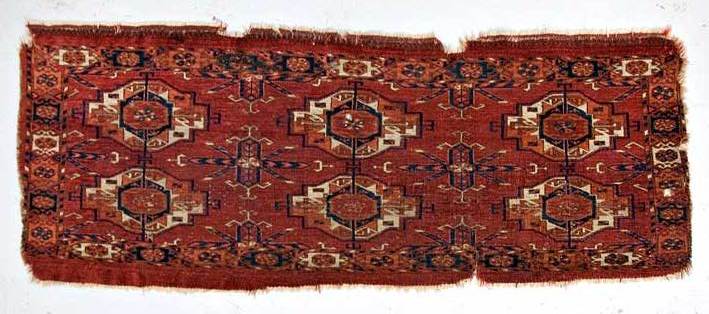
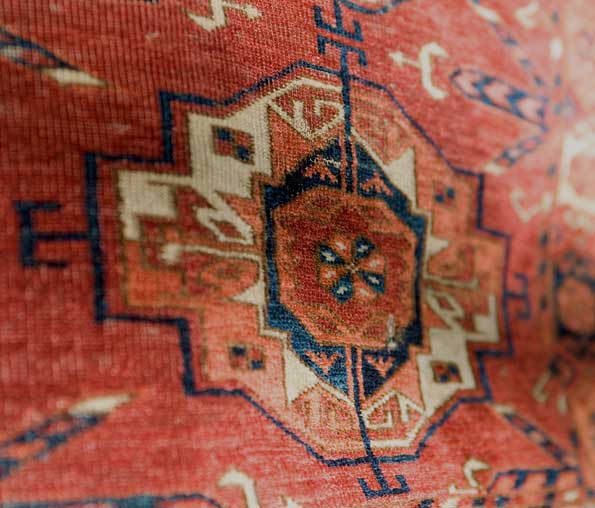
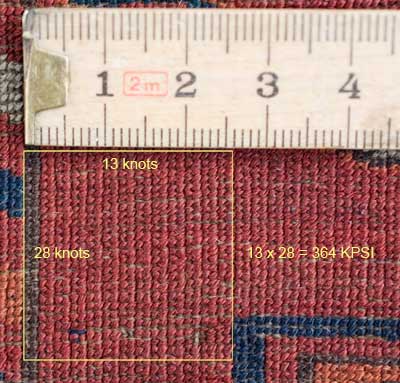
Any comments are much
appreciated
Regards Martin
Posted by Jim Allen on 04-23-2008 09:42 AM:
old thread
Martin
Your torba is pictured upside down. Your torba probably dates
to the first half of the 19th century and it could be even older. On the other
hand it could be from the later 1880's. If it was later 1880's there would be a
handful of knots dyed with synthetic red. The Tekke started increasing their
knot counts by using a hammer on the comb compacting their knots. This made the
weaving quite stiff and subject to splitting along the warps.
Every
classical era Tekke torba I have examined has had a KPSI over 300. A lot can be
learned by studying the borders of Tekke torbas. The number of colored kochank
border elements between each white background kochank border element in your
torba is four to one and I personally equate that four to one ratio with early
examples. For instance my early 18th century tekke torba has a five to one ratio
regarding the kochank border elements. The oldest Tekke weavings, with the
kochank border, do not have any white background kochank border elements. There
are two clearly different field aesthetics seen in these torbas. Tekke 6 gull
torbas were not ordinarily used, in a utilitarian sense, but during rough times
they were used and yours looks bleached out to some some degree by sun exposure.
I have collected Turkoman weaving's since the mid 1970's and the Tekke 6 gull
torba is one of my all time favorite genres. I presently own three of them. If
any of this interests you here is a good place to discuss it. Jim Allen
Posted by Martin Andersen on 04-23-2008 12:32 PM:
Hi Jim
Sorry for the upside down. It should be corrected now.
Very interesting with the development of the white in the kochank
border, I wasn't aware of that.
And I would love to se photos of the
Torbas you have kept as a part of your collection. I am sure you collection is
highly qualified.
regards Martin
Posted by David R E Hunt on 04-25-2008 12:21 AM:
Hi Martin
Wow. It's my understanding (faulty as it might be) that
another sign of age in these Tekke torba is that the motif depicted in the
center of the major gul is also be be found in the center of the kochak elements
of the border. Gotta love the details in that gul.
Any possibility of getting
a couple more photos? Some of these torba have figures drawn in the elem like,
solid color at the bottom of the bag.
Dave Hunt
Posted by Jim Allen on 04-25-2008 01:31 PM:
It Takes a Lot of Looking
After looking at Martin’s Tekke torba for a day now I must say it has a
number of rare features. The negative space formed by two adjacent kochank
border elements is very compact and frankly of a design type I’ve seldom seen
before. It certainly isn’t the usual treatment of that space and perhaps it has
something to do with the high knot count. The arrow head designs in the deep
blue surrounding the main gull centers are seldom encountered. The “T” forms
extending from every vertical and horizontal extreme is also unusual as one
generally sees only three sides decorated in this way.
Below is a
close-up of my own Tekke 6 gull torba of a similar type. It has a rare old main
border, it’s very finely woven at just over 300 kpsi, and its background color
is a rich plum / purple.
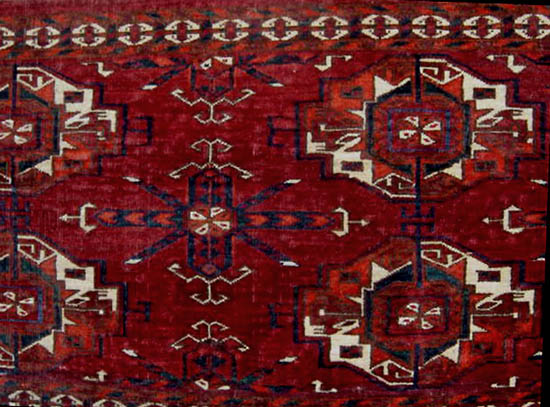
Below is a visual
presentation of Martin’s and my torbas. These torbas have an aesthetic that has
moved away from the taller gulls of earlier Tekke torbas, the ones that never
have those “T” shapes adorning their extremes. I have added contrast to Martin’s
torba trying to bring it back into register with its’ original presentation. I
don’t have a good vertical picture of my torba but I think looking at it from
the side is interesting.
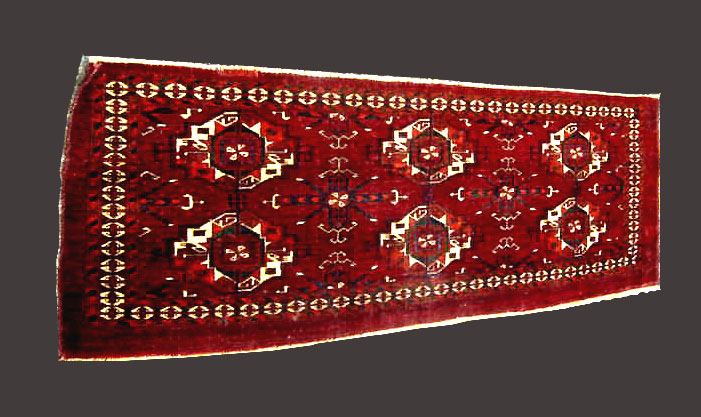
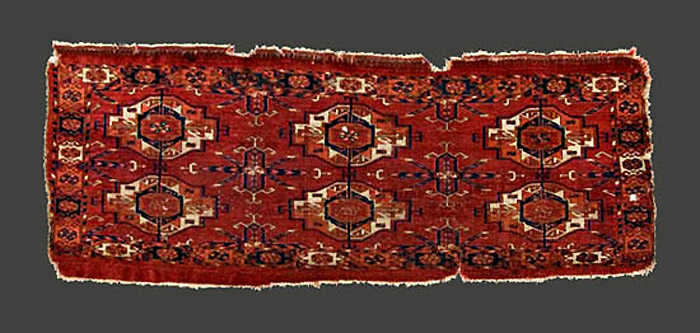
Posted by David R E Hunt on 04-25-2008 09:11 PM:
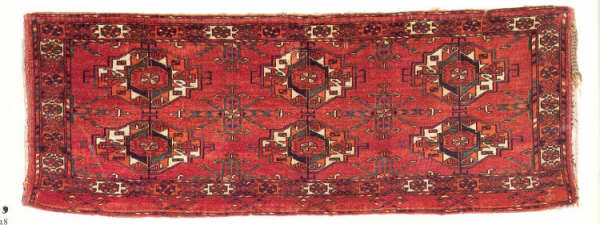
Hi
Guys
The above mentioned torba, from Thompson's "Carprt Magic", page 18.
No structural details, I'm afraid, but dimensions are 18" X 49 1/2
".
Dave
Posted by Martin Andersen on 04-26-2008 06:26 AM:
Hi Jim and Dave
Very beautiful border on Jims Torba, I would very much
like to see a close up shot.
And here are some additional photos of my
Torba. As I suppose you know capturing texture and colours of these rugs in
photos is almost impossible (at least for me). The red in my Torba is deeper and
darker than the photos show.
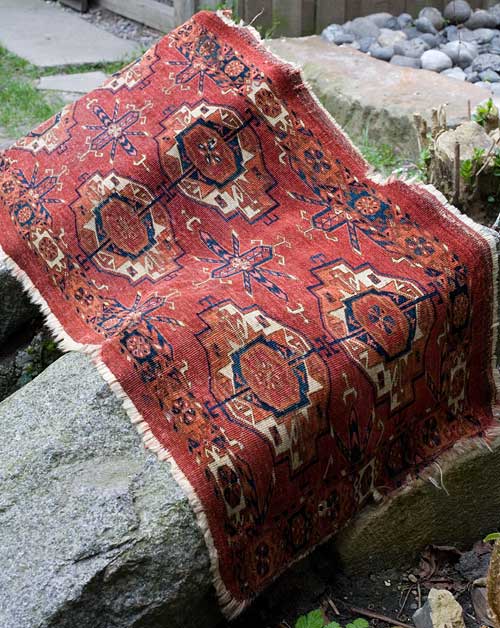
top border
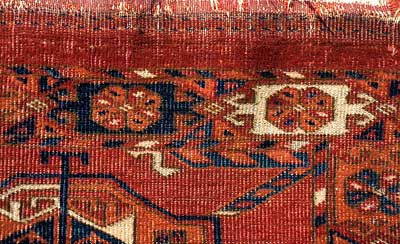
right border
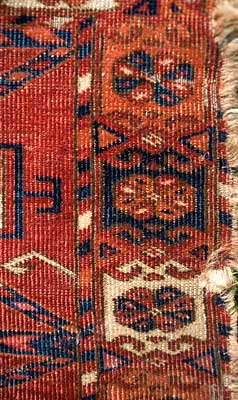
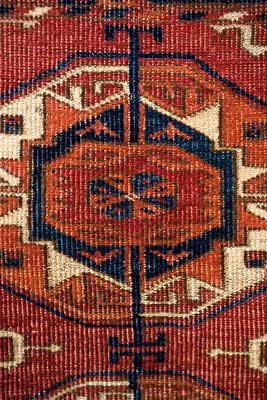
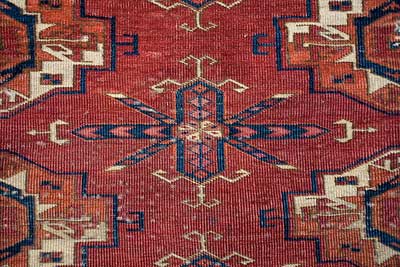
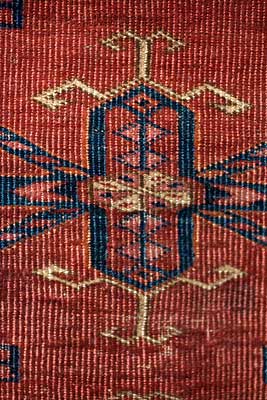
regards Martin
Posted by Martin Andersen on 04-26-2008 06:28 AM:
And here is a Torba from Powerhouse Museum with a very similar layout as
mine. http://www.powerhousemuseum.com/hsc/textiles/nomads.htm
This
Torba also has the central flower motif in both kochack border, chemsche gull,
and main gull. It also has the clear drawn “bow and arrow” motif left and right
of the chemsche gull (the “bow and arrow” motif is on all 4 Torbas we have in
this tread).
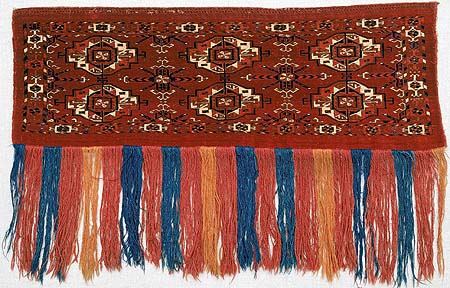
The Powerhouse Museum has dated the Torba rather late, around
1900. I suppose it could be on ground of synthetic dyes, or perhaps the fringes?
If it is that late then the ratio of white in the Kocank border supports Jims
observation of a development going from less to more white in the
border.
On the other hand Thompson's Torba looks very old even though it
has a 1:3 ratio of white in the kochank border. Any thoughts on the beautiful
“elem” on Thompson’s Torba ?
Regards Martin
Posted by Martin Andersen on 04-26-2008 06:53 AM:
And Jim, could you elaborate you thoughts on “The negative space formed by
two adjacent kochank border” ? I would be very interested. I know you have a
very specialised view on these negative spaces 
Regards Martin
Posted by Jim Allen on 04-26-2008 07:58 PM:
negative spaces
If you start looking closely you will see that there are dozens of ways the
kochank border is elaborated in the negative spaces. Some negative spaces are
very well conceived and have as much visual presence as the positive space
kochanks do. Others, like yours Martin, have a high number of kochanks and a
minimalistic treatment to their intervening negative spaces. Aside from
questions about aesthetics there is obviously a language evolving here. I feel
that the high knot count of your torba has had a big influence on the
elaboration of the details of your piece. The best learning experience in these
matters is to see a significant number of Tekke torbas at once and study them
side by side. This is something ACOR or the ICOC ought to do a hands on exhibit
of.
Posted by Jim Allen on 04-26-2008 09:05 PM:
Rare Tekke 6 gull torbas
Large S border Tekke 6 gull Torbas
The large “S” border Tekke 6 gull
torbas make a very interesting subtype to study. There are fewer large “S” tekke
6 gull torbas known then there are Tekke bird asmalyks. Below is an example from
the ex Amstey collection.
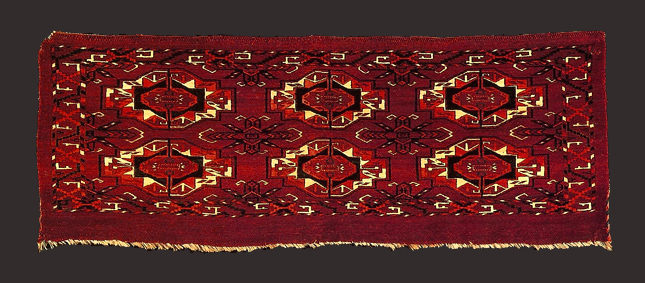
Annette Rautenstengel mentioned to me, at the recent Hajji
convention, that her most trusted female Tekke advisor/confidant flatly refused
to believe that any Bird Asmalyk was a product of the Tekke tribe. This was
something that greatly confused her. I suggested that the true Tekke Bird
Asmalyk was a totemic weaving done to decorate the Khan’s mount as he presided
over the “great hunt” when boys were turned into men. See the link below; as I
have recently written on this subject.
http://www.a-bey.com/index.php?a=119
Annette seemed to
think this was an interesting avenue of thought as these weavings might well
have been something that no Tekke woman ever saw. Bear in mind that shamen and
even Khans were seen weaving by O’Donovan. In all fairness to Annette’s
confidant, no Tekke woman may have ever seen a Tekke Bird Asmalyk in the far
fields of her ordinary experiences.
Below is my short almost certainly
incomplete list of the known large “S” border Tekke 6 gull torbas. I would love
to see any others that the Turkotek crowd has knowledge of.
1) Leigh
Marsh: best blood red example with nicely separated large “S” forms. I rank this
piece as one of the best Tekke 6 gull torbas in existence.

2) Jack Cassin: Tent Band
Tent Bag, plate # 8; the only example with saryk tertiary forms and primitive
almost unreadable “S” forms. I once assigned this torba to the middle of the
19th century but now I wonder how old it truly is. This unusual Tekke torba has
a unique aesthetic, as far as I can tell, with its lateral main gull extremes
cut off by the border.
3) Munkacsi and D’Heurle: recently acquired a
Tekke example in San Francisco with the large “S” border rendered somewhat
similar to the Cassin example. This torba is sun bleached.
4) Sam Coad
sold a classical Tekke 6 gull torba with the large “S” border, as I remember. A
great piece and I heard it was sun bleached as well.
5) Marvin Amstey’s
favorite Tekke 6 gull torba was a large “S” border Tekke torba that he published
in Vanishing Jewels, image # 50. It is pictured first in this short note and it
is not sun bleached.
6) Munkacsi has a Chodor-esq three full gull six
half gull torba with the large S border. I wouldn’t rule out its being Tekke
though it has Chodor coloring and aesthetic.
7) and beyond ……I am sure
there are more examples and I truly want to see them all.
Jim
Allen
PS Martin...if that is a light violet color in the outgoing chevron
designs in the lateral horizontal arms of your chemche minor gulls then those
small sections may be dyed with lac. It now seems apparent that the Salor
controlled the lac trade and the Salor used it extensively before about 1800 AD.
If your Tekke torba has any lac in it then it is almost certainly an 18th
century Tekke weaving. This is fairly recent news and it comes from Rageth who
has shifted his attention away from C-14 examinations and towards sensitive dye
analysis in his ongoing research.
Posted by Martin Andersen on 04-27-2008 04:21 AM:
Hi Jim
Here is a scan from Hans Elmby ”Antique Turkmen Carpets
V”.
There are no structural analyse in No V, but Elmby dates the Torba 1750
or earlier . He also relates it to another published Torba , “P. Hoffmeister:
Turkoman Carpets. Edinburgh 1980, no 25”
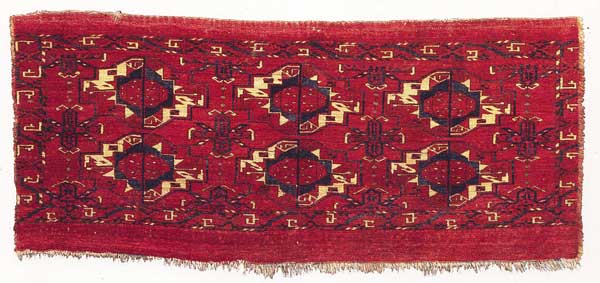
regards Martin
Posted by Martin Andersen on 04-27-2008 06:59 AM:
lac or cochineal?
I am not able to tell the difference of Lac color and Cochineal. And I
suppose it’s even harder if the color has been bleached by the sun ? Is it
possible to tell the difference visually ? Or does it require some chemical test
?
The use of the light violet in my Torba is very sparse. And I find
that it is used very deliberately to underline the horizontal aesthetics of the
Torba format. The light violet color is mainly used across the horizontal
centreline of the Torba. The effect of this underline may have been stronger
when the pile was full and the colours less bleached.
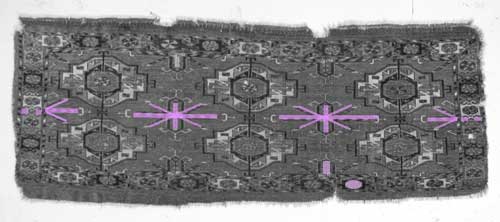
regards Martin
Posted by Jim Allen on 04-27-2008 07:54 AM:
lac
At this point, assuming you have a true violet color, I would assume your
torba contains lac as cochineal produces a rosy red with blue undertones and not
violet on wool. It seems funny but those few knots of violet in the next few
years will assume a great deal of importance. I was happy to see the Elmby
example, though I don't see any real relationship to Hoffmeister's #25, a torba
I am quite familiar with. It is in fact the oldest Tekke torba known at this
time. Soon we will all be singing follow the lac down the yellow brick road.
Rageth has found lac in something like 80% of all Salor weavings. Finding lac in
either a Tekke or Yomud weaving indicates to me an 18th century dating as the
lac basically had to come from trade with the salor of the 18th century. Jim
Allen
Posted by Ben Mini on 04-27-2008 09:15 AM:
lac
Dear Jim,
In your last post you write, "Rageth has found lac in
something like 80% of all Salor weavings. Finding lac in either a Tekke or Yomud
weaving indicates to me an 18th century dating as the lac basically had to come
from trade with the salor of the 18th century."
I don't quite understand
your logic here. First of all, Rageth has reported the existence of lac in Salor
weavings from as late as the end of the 19th century. He dates these pieces to
the late 19th because they contain both synthetic dyes and lac. Rageth made
these claim at Acor 8 during his presentation "Scientific Techniques in Oriental
Carpet Studies."
If it's true, as you claim, that the Salor controlled
the lac trade, it seems like you could have bought some lac off of them up
through the early 20th century.
Ben Mini
p.s. Martin, I really
like your torba.
Posted by Richard Larkin on 04-27-2008 10:28 AM:
Hi Martin,
In your post of April 26, in the last two images, there is
a pale pink or violet color in some diamonds on the vertical element of the
secondary gul and also in the chevrons along the horizontal. Is this the "lac"
color of which we are speaking?
I also like your torba. It doesn't look
especially "bleached" to me.
__________________
Rich
Larkin
Posted by Martin Andersen on 04-27-2008 11:09 AM:
Hi Rich
Yes they are the ones. Colours are of course difficult to
present on the net. The hue of the color is more blue then madder, and I would
have thought it to be cochineal, as I have no experience with the Lac
color.
Here is another detail shot (taken in shadow) of some of the violet
colored parts in the center of the chemche gull :
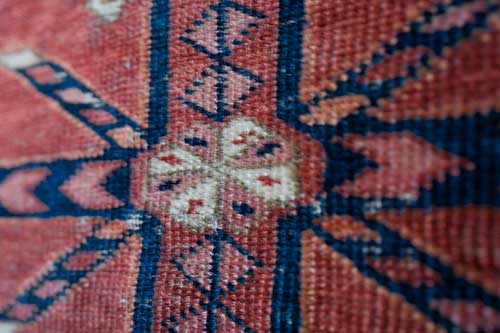
regards Martin
Posted by Richard Larkin on 04-27-2008 12:32 PM:
Thanks, Martin. My mental picture of "lac" was much more brilliant red. But I
can't say what is was based on. We live and learn.
__________________
Rich
Larkin
Posted by Jim Allen on 04-27-2008 01:16 PM:
Lac
I am pretty sure the Salor were the only post 1800 AD tribe to still use lac
late into the 19th century. I was thinking stored up reserves for the source.
The reason is economic. Cochineal was deemed effective and desirable plus it was
cheap. Many Salor main carpets have field colors dyed with lac. Lac was
extremely expensive and hard to produce. Lac had been the principle replacement
for Tyrollian purple of early first millennium AD. Surely this isn't all 100%
true but can you find an obviously later yomud chuval with lac in it? I think
all Yomud chuvals or torbas with lac date to the first half 18th century unless
other factors clearly point in another direction. Same goes for Tekke torbas.
Jim
Martin....that looks like lac in your torba to me.
Posted by Martin Andersen on 04-28-2008 02:49 AM:
I would very much like to see samples of other 6 Gull Tekke Torbas with use
of light violet highlights.
It is hard to see in these photos but Leigh
Marsh’ Torba, from earlier in the tread, also seems to take use of violet to
underline the horizontal central chemsche gulls.
Leigh
Marsh’ Torba
.jpg)
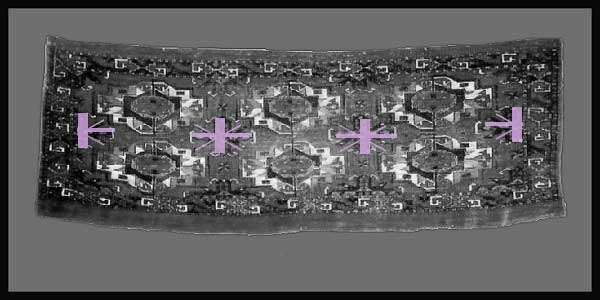
Perhaps one could speculate that earlier rugs used Lac in
these highlights, while later rugs exchanged this luxury with cochineal silk
colors ?
And Jim - thank you for putting the attention to the light
violet (and adding a possible 100 years to my Torba , that does make the low pile more
acceptable). You certainly have a sharp eye, spotting that color in my first
colorvise rather poor photos. In general details like that is hard to spot in
published material.
, that does make the low pile more
acceptable). You certainly have a sharp eye, spotting that color in my first
colorvise rather poor photos. In general details like that is hard to spot in
published material.
Regards Martin
Posted by Ben Mini on 04-28-2008 09:05 AM:
lac, cochineal, fuchsine
Actually, I do think that I have seen lac in later yomud work. I don't think
that it's very common, but I think it happens on occasion. I know of one yomud
piece on the market right now that is described by its knowledgeable seller as
circa 1900 and containing either lac or maybe fuchsine.
I also remember
another yomud chuval I saw a few years ago which I would have described as mid
19th ish, and which seemed to contain some lac highlights.
To be honest,
though, I think it's fairly hard to differentiate insect dyes with my eyes. I
guess cochineal is supposed to be a little bluer and poppier than lac, but I've
seen some fairly subdued and violet tones of cochineal in some Anatolian pieces.
And then there's good old fuchsine: a dye that seems to fade in many different
ways and can sometimes appear suspiciously like an insect dye.
I'm
certainly no expert on Turkoman rugs, but I've been working under the assumption
that Lac is a pretty neat thing to find in a Turkoman. It's likely more common
on older pieces than newer ones, but it does show up occasionally on newer ones
too.
I guess I'm just suggesting that there isn't a rule about Lac-- that
it doesn't necessarily date a Turkoman piece to an early period.
Ben
Mini
Posted by Jim Allen on 04-28-2008 09:26 AM:
Ben
There is one other possibility. The Yomud you "saw" lac in was much earlier
than mid 19th century or the dye wasn't lac but something else. I mention this
because Yomud work is often earlier than we think. The Yomud were the strongest
tribe in the period before the Tekke achieved ascendancy. This fact just isn't
usually taken into account when factoring the age of a Yomud chuval. Certainly
there are plenty of later ones but after a few years of looking the two groups
become more distinct. A raptorized running dog border is a big tip off as is a
fine weave. The aesthetic techniques used to make the gulls appear to be flying
are also very characteristic of the oldest Yomud chuvals. I think the day is
fast approaching when dye analysis is going to really take off. Jim
Posted by Martin Andersen on 04-28-2008 10:31 AM:
It is quite provoking how difficult it is to establish both chronology and
subgroups regarding these rugs. Rugs which are so obviously systematic and
consistent in their layout. And obviously so consecutive in their aesthetical
development. But I suppose that’s a part of the fun 
Martin
Posted by Martin Andersen on 04-28-2008 03:50 PM:
I think here is another Torba with the S-border, the reproduction is rather
small. It is copy pasted from this web page: http://www.krausse-muenchen.de/deutsch/2hali112.htm
Krausse Torba
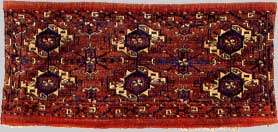
And perhaps the following Torba from Pinner’s collection
also has a violet colour in the horizontal centreline? http://www.jozan.net/gallery/AuctionInvent.asp?User=RipponBoswell150504&Item=1185
Again the image seize very small, but I think there is a small bluish tone
in the centre Chemsche Gulls ?
Pinner Torba
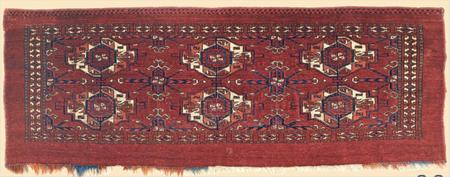
Regards Martin
Posted by Sue Zimmerman on 04-29-2008 09:36 AM:
Jim,
If you are having trouble dyeing wool violet with cochineal it
may be due to the water you are using. Try an after bath with non-sudsing
ammonia. If that doesn't work there are many other ways. Ammonia is the cheapest
and easiest, though. I've never heard of this problem before. Is your water
acidic? Sue
Posted by Martin Andersen on 05-03-2008 08:27 AM:
Kochank, Kochanak border
Hi All
After looking around at the kochank border on published Torbas,
I see that Jim is right again. The normal intersection in the negative space in
the border is made of “ram’s horns” all the way round. On my Torba the
intersection is made up by multicolored triangles. Not sure what to make of it,
but anyway peculiarities does give character to a rug.
Kochank border top:
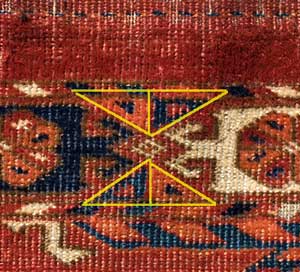
Kochank border right side:
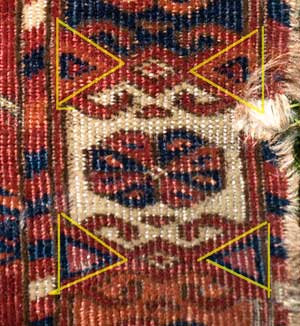
More
conventional kochank border:
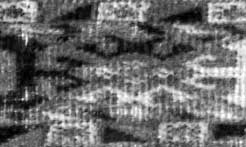
Regards Martin
Posted by Jim Allen on 05-03-2008 09:46 AM:
Kochank border
The best drawn kochank borders are on 14th & 15th century Anatolian
carpets. One must study these in order to know what the design looks like in its
most optimized conformation. Taking a design from one matrix or milieu to
another, say for instance from these early Anatolian kochank carpet borders to
later Turkoman kochank torba borders, is similar to transposing music from a
guitar to a violin. This isn't something that comes naturally and requires deep
understanding of the material. My mid 17th century C-14 dated Tekke chuval had
an absolutely classical kochank border and it was woven at 326 KPSI. That
required a big leap or adjustment by the weaver to make her kochank design work
out correctly. One will notice in the genre of Tekke 6 gull torbas that there
are diagonal and non diagonal coloring patterns for the kochank negative spaces.
This is a profound adjustment. The earliest torbas have very few to zero white
kochanks. Martins torba is quite possibly an early torba and its kochank defined
negative spaces are affective in their drawing but also very minimalistic. It
makes sense that these adjustments may have found favor in the larger community
and perhaps for a generation or two they formed the bulk of fashionable kochank
design. It may well be possible to characterize Tekke 6 gull torbas with kochank
borders simply based on their negative space elaborations. Also the rosette
undergoes changes that are about as frequent and profound as the negative space
treatments are. Beneath the superficial similarity one initially perceives in
this genre there run threads of generational differences that make them each and
every one unique. Now isn't this fun! Jim
Posted by Martin Andersen on 05-04-2008 06:18 AM:
Hi Jim
Actually the negative space perhaps looks more “Anatolian” than
the positive space
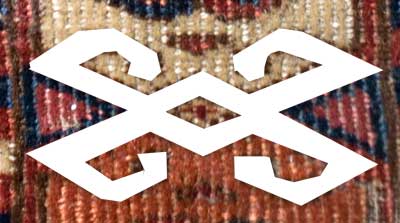
Regards Martin
Posted by Jim Allen on 05-04-2008 09:39 PM:
colored triangles
Martin:
In the vertical border segments of your torba the kochanks have
well done rosettes and the usual kochank shaped background. In addition the
vertical kochanks of your torba have colored triangles in the kochanks body at
zero and one hundred and eighty degrees. I think these triangles were meant to
be seen as working with the negative space forms to bring the segments into
tight relationship like the links of a chain. I have looked at a lot of Tekke 6
gull torbas and frankly I can't remember ever seeing those triangles before. I
would be very pleased if someone can show me another example as I think it would
help us better understand Martin's torba. Jim
Posted by Martin Andersen on 05-05-2008 07:56 AM:
Hi Jim
Here is a scan from Hans Elmby ”Antique Turkmen Carpets IV” plate
no 5. It has the same small triangles in the positive elements of the vertical
Kochank border.
Elmby IV no 5
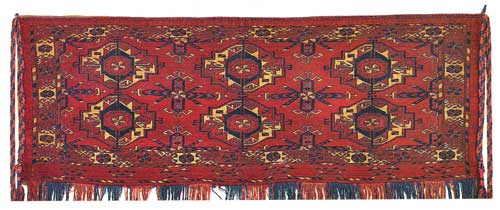
As far as I can see on the
small photo it doesn’t have the triangles in the intersections. But the ram
horns in the intersection almost looks like triangles. If one could talk of a
development, I wonder which way the development have moved in the intersection,
from triangle to ram horns - or visa versa ?
Detail, Elmby
IV no 5
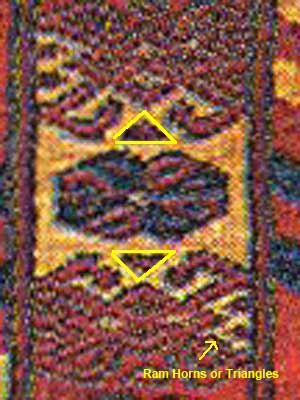
Elmby dates it 1850 or earlier. It has a knot count on 4600
kn/sqdm = 297 kpsi.
If my knot counting isn’t flawed, then the 364 kpsi of my
own Torba seems very high. Actually I haven’t found any other published Torbas
with that high kpsi.
regards Martin
Posted by Richard Larkin on 05-05-2008 10:16 AM:
Hi Martin and Jim,
Martin, my best count of the vertical row of nodes
in your (excellent) image is 25 (rather than 28), which renders a count of 325
psi. Still pretty fine.
Jim, intending not the least offense, I must say
I find much of your deep analysis of these Turkoman weavings in terms of the
function and purpose of small details, particularly as they bear on issues of
"negative space," not to be very convincing to me. At the same time, you are
certainly a visionary, and the lack of understanding may well be on my own part.
At least, your ability to produce these insights is impressive and fascinating.
Having said that, I am curious to know whether your views have gained wide
support or acceptance among other Turkoman scholars.
__________________
Rich
Larkin
Posted by Jim Allen on 05-05-2008 04:06 PM:
Insight
Rich:
My first serious insight concerning Turkoman weaving concerned the
non accidental nature of three dimensional representation in very old Turkoman
chuvals. I published my rough ideas as an article in Hali #55. My thesis caught
the attention of Dr. Craig Carriere who took digitized images of the pieces in
question and scored them on a scale between 2.0 and 3.0, using an advanced
algorithm. He calculated very high scores (approx. 2.8) for the two chuvals I'd
choosen as representative of the oldest Turkoman aesthetic. Nobody took much
notice of this finding but I later found that museum curators the world over had
noticed it. With help from Nobiko Kajitani of the MET and Kurt Munkacsi, present
president of the Hajji Baba Club, I submitted my chuval with a very high
dimensionality quotient for C-14 analysis to Arizona University and Dr. AJT
Jull. He found that my Tekke chuval, the one that I felt was representative of
the oldest Turkoman aesthetic, was mid 17th century. At the time this was
revolutionary information and permanently planted the idea that certain Turkoman
weavings were drawn three dimensionally as part of an ages old tradition. I
caused a tipping point to occur in Turkoman aesthetic appreciation. Our work was
published in Oriental Carpet and Textile Studies 5 edited my Pinner and Eiland.
I was very proud to recently hear Jon Thompson say to me in public that he had
determined that the whole three dimensional thing, relative to Turkoman drawing,
rested at my feet.
Jim Allen
Posted by Martin Andersen on 05-06-2008 04:36 AM:
Hi Rich
You are probably right about the knots, those little bastards are
hard keeping in line 
And Thought I personally cant always follow Jims imaginary thinking (a
thinking which Jim often enough presents as hypothesis and hyperbolian
thinking), I at the same time find it very fascinating.
And I do certainly
have a lot of respect for his vast experience and sharp eye - and his
willingness to share this experience. And on a topic like this, the Torbas, the
published literature is, as far as I can see, very general and not very specific
or detailed. I am very grateful for anyone how is willing to share thoughts and
knowledge on this.
And I suppose we all know that knowledge and insight
sometimes moves in mysterious ways 
Martin
Posted by Richard Larkin on 05-06-2008 07:55 AM:
Hi Martin,
You are right, Jim does have a very sharp eye for the
detail others take for granted. You can't go wrong paying attention to the fine
details of these weavings. Jim, I delved into the attic (my poor version of the
state of the art secure bunker Mr. Weiler supervises) and found Hali 55. I'll
read your article with pleasure, and maybe come back with comments and
questions.
__________________
Rich
Larkin
Posted by Martin Andersen on 05-11-2008 07:01 PM:
Hi All
I wonder about the function of these Torbas. The horizontal
format seems to be an invention of the Turkmen? As a travelling bag the large
horizontal opening can’t have been very practical? Aside from Torbas and
Chuvals, are there any other horizontal bags from other nomadic
societies?
There seems to be some consensus that the Torbas was a non
utilitarian part of the dowry, but that gives no real answer to the rather
strange horizontal format of these bags (which are still bags). Any thoughts on
what could have been in these bags? Sticks? Bow and arrows? And it seem like the
Tekke stopped making these Torbas rather soon after the Russian colonization? At
least I haven’t seen any Six Gull Torba that I would think was from the 20th.
Earlier in this tread Jims mentions the Bird Asmalyks (I suppose Jims
interest in the curved border on some Torbas are connected to the curved border
on the Tekke Asmalyks). As far as I have understood the Asmalyks are generally
also seen as a part of the marriage ceremonial. If they are then it seems rather
strange that Tekke Asmalyks are so very rare. Marriage is a rather frequent
thing.
Well I suppose there are no final answers to these questions, but
I would be interested in any thoughts and speculations on the topic.
Regards Martin
Posted by Steve Price on 05-11-2008 07:32 PM:
Hi Martin
One of the interesting things about comparing the
utilitarian textiles made by Turkmen with those from NW Persia and the Caucasus
is that they're so different. The two regions are only separated by the Caspian
Sea, so they surely interacted.
Turkmen make lots of pile weavings, some
flatweaves. The NW Persian/Caucasian tribal people make mostly flatweaves,
occasional pile weaves.
Turkmen make lots of torbas, juvals,
spoon/spindle bags, an occasional prayer rug, an occasional khorjin. No cargo
bag (mafrash), no salt bags. NW Persian/Caucasian tribal people make no torbas,
an occasional juval, no spoon/spindle bags, lots of salt bags, lots of mafrash,
lots of khorjin.
I find the difference as striking as the difference in
what's used as eating utensils (forks and spoons vs chop sticks), which also
changes abruptly over a short distance.
Steve Price
Posted by Martin Andersen on 05-13-2008 06:14 AM:
Hi Steve
Yes cultural borders can be sharp, and sometimes they seem
rather arbitrary. I suppose langue and the general hostilities have constituted
a sharp cultural border between Persia and the Turkmens.
Of course the
Torbas may have had the specific shape from being partly an utilitarian bag -
and partly a non utilitarian wall hanging, as a part of the extensive dowry
ceremonials. I suppose a wall hanging in a yurt would to be more displayable in
horizontal direction ?
Regards Martin
Posted by Richard Larkin on 05-13-2008 08:52 AM:
Hi Steve,
I never thought much about the differences in the output of
these two groups until you mentioned it here, though it is obvious when you
think about it. Would you agree that the Kurds, particularly the weavers of the
"Jaff Kurd" repertoire, blur the distinction somewhat?
__________________
Rich
Larkin
Posted by Steve Price on 05-13-2008 09:57 AM:
Hi Rich
Most of Kurdistan falls outside the range of either the
Turkmen or NW Persian/Caucasian tribal folks, so I don't see Kurdish weaving as
having much bearing on the general distinction between those
two.
Regards
Steve Price
Posted by Richard Larkin on 05-13-2008 11:44 AM:
Hi Steve,
I understand that. You noted that the two groups (Turkoman
and NW Persian/Caucasian, respectively) produced significantly differing
repertoires of utilitarian woven goods, notwithstanding their relatively close
proximity, not to mention long standing weaving traditions. I found that
circumstance remarkable once you brought it to my attention, especially
considering the imitation that one might expect to take place among such peoples
who had ample opportunity to observe one another.
My point was that I
thought the differences in the range of functional woven goods were less clear
cut when one brought the Kurds into the equation, comparing to either or both of
the other two. In particular, I think the range of sizes among Kurdish woven
bags is much greater and less regimented. It's not a very important point. As
far as geographic distribution is concerned, the Kurds are varied and scattered,
but they have a prominent representation in the NW Persian area, and some in the
Caucasus as well.
Posted by Steve Price on 05-13-2008 11:55 AM:
Hi Rich
I understand now. I guess it does fuzz the edges some.
Your word, "unregimented", strikes me as the very essence of Kurdish
weaving. Wish I'd thought of it first.
Regards
Steve Price
Posted by Richard Larkin on 05-13-2008 01:04 PM:
Hi Steve,
The larger question implicit in your observation, of course,
is the apparent anomaly of the relatively slight incursion of utilitarian
weaving habits and formats from the one group into the other. Removed as I am
from the venues of these groups, perhaps I have an inaccurate sense of the
amount of historical interaction and association among them. One would imagine
somewhere along the line, some Turkoman women would have spotted a few salt bags
and gotten inspired. One wonders whether there was studied avoidance involved,
based on perceived superiority of one's own clan.
There other instances
of utilitarian formats that seem to have been limited to specific groups as
well, though others presumably had opportunities to take them on. Balishts of
the Baluchi groups come to mind, with the opening at the narrow side of the bag.
No doubt there are others. We can probably agree in general that the Turkoman
lead the league in odd and obscure functional weavings.
Posted by Steve Price on 05-13-2008 01:22 PM:
Hi Rich
Turkmenistan is on one side of the Caspian Sea, Azerbaijan and
NW Iran are on the other, separated by modest distances. There are major cities
on both sides (Derbent, Lenkoran, Baku, Turkmenbasi, among others) and a number
of rivers running into it with more cities on them. It's hard to imagine that
there wasn't lots of interaction between the peoples of both groups. If I'm
having a lucid moment, the Shahsevan were put into that region to protect the
Azerbaijani from the Turkmen.
Yes, the Turkmen made specialized
containers for all sorts of things. I have an oddball pile container that turns
out to be a bag for a weaver's comb. The dealer who sold it to me thought it
might be a tea cozy.
Regards
Steve Price
Posted by Jim Allen on 05-13-2008 08:35 PM:
Tekke Torba uses
Just from the color perspective: many Tekke torbas obviously didn't see any
significant amount of time in the sun. Those that were used in a nomadic and
utilitarian fashion outside in the sun often show sun bleaching of the natural
dark brown to a light brown. This lighter brown color can be so light it fails
to properly "confine" the colored forms it outlines and this is visually
irritating. More sun bleaching causes the madder reds to significantly lighten
but the blues are amazingly stable. I have seen a hand full of truly early Tekke
6 gull torbas and they were all unbleached. I believe this means that many of
this type weaving were only hung up inside of the yurt and in the larger context
they were passed down through the generations as heirlooms. I think they would
also have served as teaching aides for future generations. This just begins to
tell the story of why one Tekke 6 gull torba may sell for 25,000 usd at auction
and another one fairly similar looking only makes 2,500 usd at the same auction.
I have noticed on spindle bags, igsaliks, that there is always a
particular kind of damage on their backsides to the knots, a little distance
from their depths or bottoms. This damage was caused by the bulge in the
spindles constantly grinding into them while moving camps etc. This is one of
those rare instances when a function can be deduced for a Turkoman weaving from
damage caused by the articles stored inside of it.
Jim Allen
Posted by Martin Andersen on 05-14-2008 03:04 AM:
Hi All
One thing that perhaps indicates that the Torbas was primarily
produced for wall hanging is the completely missing decoration of the backside
piece. The backsides (which seems to rarely have survived to our time?) were
undecorated and uncolored plain weave. The backside of other tribal bags seems
to at least to have been made of colored yarn.
Martin
Posted by Steve Price on 05-14-2008 05:47 AM:
Hi Martin
Actually, you just put your finger on yet another odd
difference between utilitarian bags produced by Turkmen and those produced by NW
Persian/Caucasian peoples. The backs of Turkmen bags are, almost without
exception, undecorated. The backs of NW Persian/Caucasian peoples have
decoration on all sides, the simplest being stipes of alternating color.
We did a Salon awhile back on bags with interesting backs. Here is
a link to it.
Regards
Steve Price
Posted by Martin Andersen on 05-16-2008 03:32 AM:
Hi Steve
Interesting treads about the backs, but a lot of the photos
seems to be gone?
And I am sorry if I am stating the obvious, especially
for long time members of this forum, where the Turkmen stuff may be a beaten
horse.
But I suppose one more thing that may define the Torbas, and most
of the other Turkmen bags as mainly non utilitarian, is the missing closure
system? Even for wall hanging they can’t have been very practical if there were
any serious weight in the bags. I must admit have never really understood the
long strings at the top left and right side of the bags. The strings can’t have
been used for closure of the bags, only for wall hanging? And I suppose the bags
would bulge rather strangely if they were heavily filled and only hanging in 2
points 1 meter apart. I would think that at least a third string in the middle
would be needed to distribute weight without deforming the bags.
Some old
photos of the internal of the yurt with the bags in use sure would have been
very interesting .
Regards Martin
Posted by Marty Grove on 05-16-2008 08:21 AM:
Not complete
G'day Martin, Steve and all,
Mart, knowledge of the Turkmen is not
nearly complete - for a good source on the state of play in Central Asian
weaving, including those outside 'the' Turkmen tribe, if you are able to find a
copy of Timbuktu to Tibet by Jon Thompson, it will be of much
benefit.
Patricks mini Salon has lead ins to the book. I got mine from
England and the lady said I had the third last copy they had and that was last
week. There may be other copies elsewhere, but at the time, I wasnt able to find
one on the Net.
The book even has photos of 'torba' bags on the tent wall
showing the permanent curvature which comes from their long term
hanging.
As for these particular weavings being generally found in the
past 100 years in decent condition, it possibly shows they were treated with
respect. Today we ourselves have weavings we hold in awe and make sure they
remain unharmed as best as possible. So it goes with something so beautiful as
these woven gems.
Mind you, from a particular photograph on page 121 I
think it is (in the above book) there is shown the master of the tent lounging
with his family, strong heeled boots rucking up the rug beneath his feet. I
always thought in those days they took their footwear off on entering the tent,
forgetting of course just how cold it gets there.
With the boots shown in
the picture, and the rugs probably on slightly uneven ground, not boards, the
weavings might get battered quite a bit more than those underfoot in our own
homes! so Im not surprised they
cannot be found for sale on every street corner...
so Im not surprised they
cannot be found for sale on every street corner...
Its a nice book, not
expensive considering, and I apologise if it has been spoken of too much outside
Patricks Salon.
Regards,
Marty.
Posted by Martin Andersen on 05-17-2008 03:59 AM:
Hi All
Just found a Torba with some detailed photos that I think
would be interesting for a closer look on design development in the kochank
border. This Torba is dated mid 19th, and it is obviously that old, if not older
?
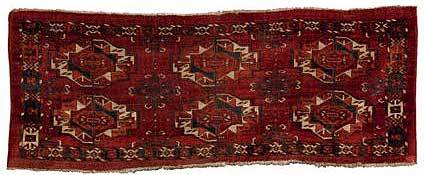
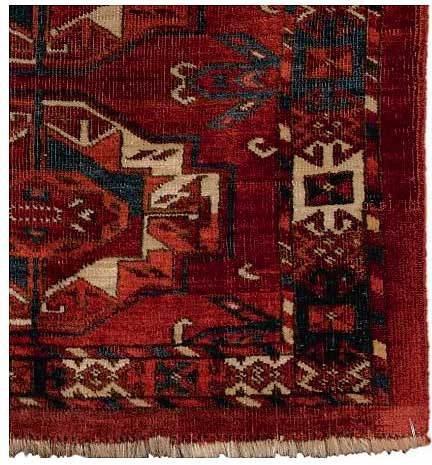
The border is somehow
designvise in between other more clearly drawn borders. The top and bottom
border is of course still the kochank border, but the drawing of both the boxes
and the rossets is almost washed out.

I would say you can’t
make a drawing like that without first having a much more clear original drawing
(like the one on my own Torba) which has been copied quite a few times.
At
the same time there in the top and bottom the space between the kochank boxes
almost stands out as new pattern.
Martin
Posted by Martin Andersen on 05-23-2008 06:47 PM:
Hi All
Here is a scan of a 12 gull Torba, no. 28 in “The Rickmers
Collection” by Robert Pinner. Pinner dates it first half of 19th. Kpsi
232.
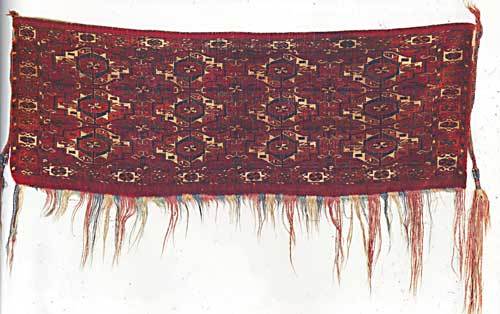
It
has a similar kochank border as my own Torba, with the multicoloured triangles
between the border cartouches.
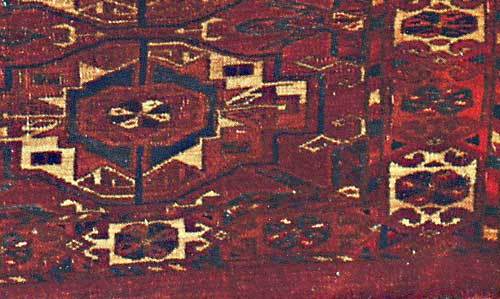
In the tread about
Tekke main carpets Jim mentions the possibility of Torbas floating around under
forum members beds. I certainly would like to see some photos, and some details,
from any of them. Perhaps of the beds too 
I find that one of the great things
about Turkotek is the close-up photos which are so rare in the
literature.
Regards Martin
Posted by Martin Andersen on 05-25-2008 10:05 AM:
Hi All
Just a final post, if nothing else turns up.
Looking at
the back of my Torba I came across this little fellow in the lower right corner
:
Photo from the back
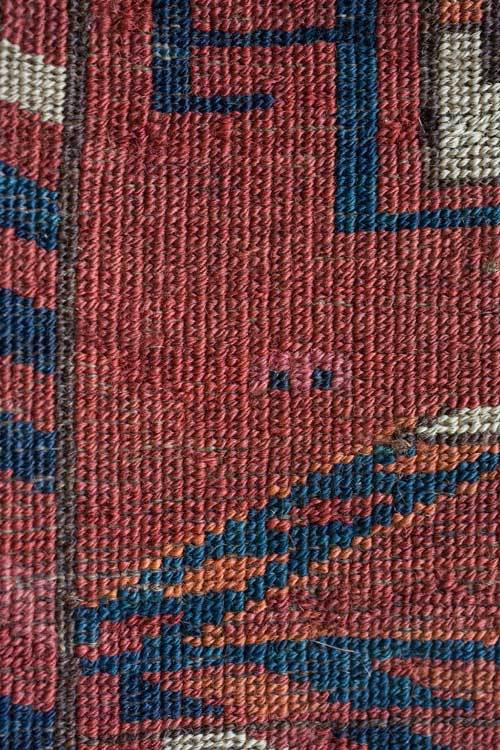

It is certainly intentional,
its not a mistake and its not a part of any pattern. I suppose it’s a kind of
signature ? Or perhaps some kind of amulet ?
Regards Martin




















.jpg)















